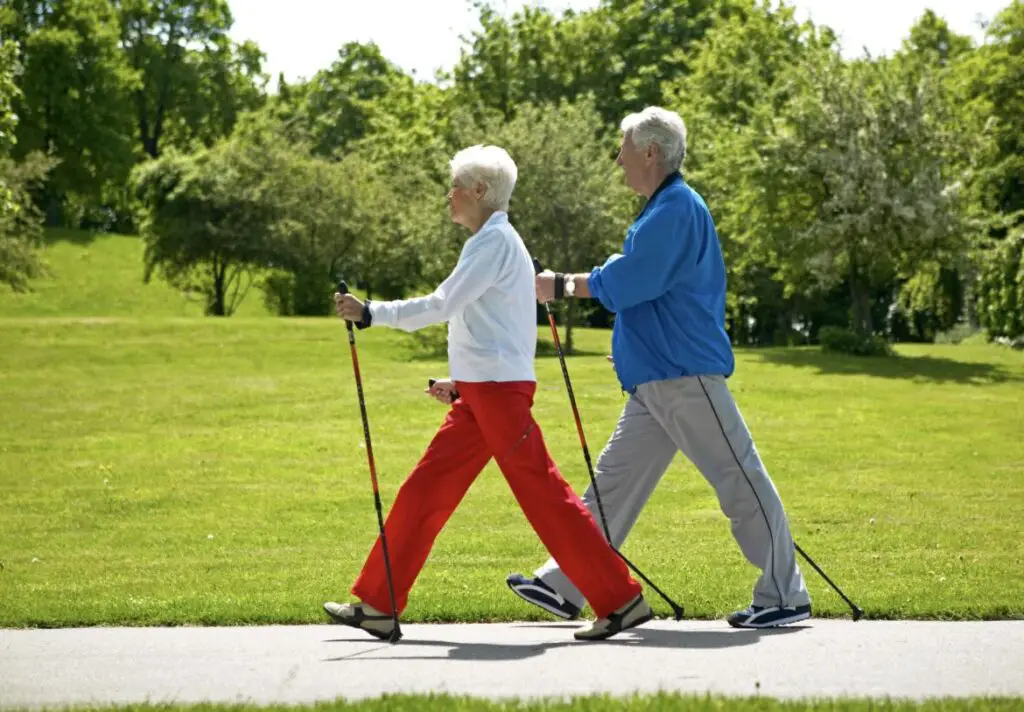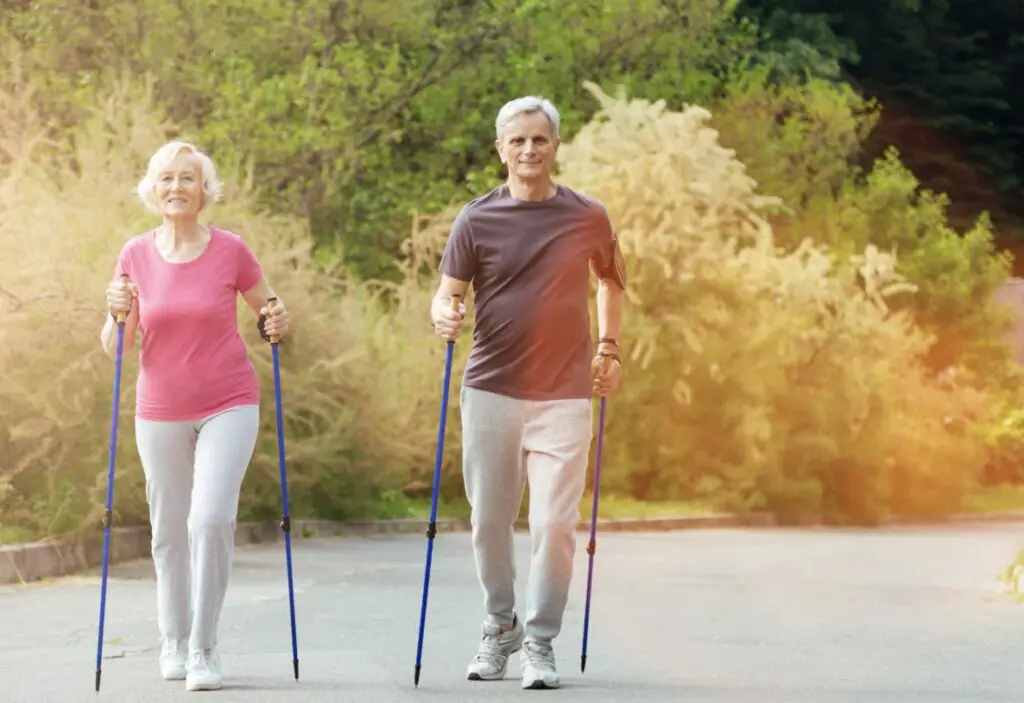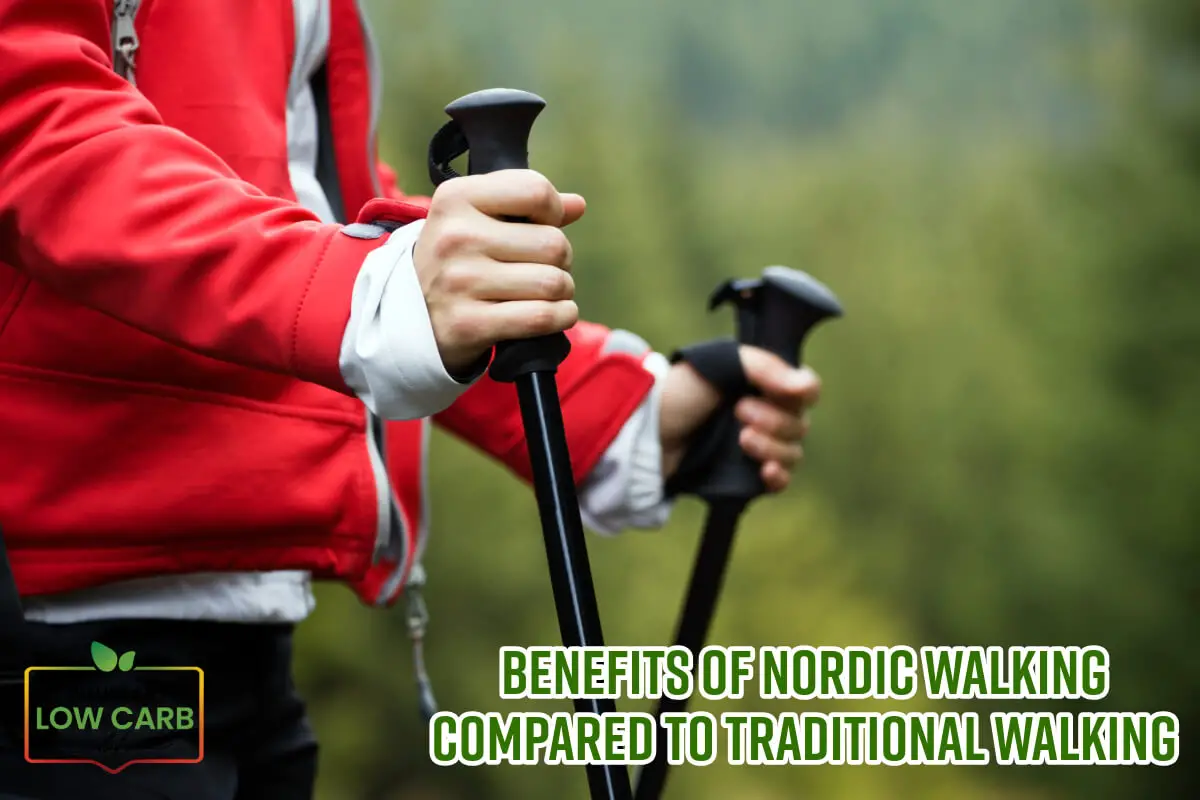Recently, some USA-based Costco stores introduced Nordic walking sticks to their inventory, a move that might surprise some shoppers, given that Nordic walking isn’t as widely recognized in the United States as it is internationally.
Nordic Walking is a form of exercise that enhances traditional walking by incorporating specialized poles. Nordic Walking offers many health benefits, making it a popular choice in various parts of the globe. Adding these poles transforms a simple walk into a full-body workout, ensuring that practitioners reap more than just the typical advantages of walking. Beyond comprehensive physical exercise, Nordic walking brings several other benefits, highlighting why it’s superior to regular walking.
Table of Contents
- Stepping Up The Pace: The Comprehensive Benefits Of Nordic Walking Compared To Traditional Walking
- From Start To Stride: A Beginner’s 3-Month Nordic Walking Plan To Reach 3 Miles
Stepping Up The Pace: The Comprehensive Benefits Of Nordic Walking Compared To Traditional Walking
Walking is a universally embraced exercise in the quest for fitness and wellness, cherished for its simplicity and minimal requirements. However, Nordic walking has introduced a dynamic twist to this traditional activity, transforming it into a comprehensive workout that engages the entire body more effectively than regular walking.
By incorporating specially designed poles, Nordic walking amplifies the benefits of a simple stroll into a full-body workout, offering many advantages for people of all ages and fitness levels. Let’s delve into the distinctive benefits of Nordic walking compared to regular walking and highlight how adding poles elevates the walking experience.

The Evolution Of Walking: Adding Poles to the Mix
Nordic walking originated from cross-country skiers’ off-season training regimen, aiming to replicate skiing’s physical benefits without the snow. The activity involves using two walking poles, similar to ski poles, which are used to push against the ground with each step.
This addition transforms walking from a predominantly lower-body exercise into a balanced workout that simultaneously challenges the upper body, core, and leg.
Engaging The Upper Body
One of the most significant benefits of Nordic walking is its ability to engage the upper body. Regular walking primarily works the lower body muscles – the quadriceps, hamstrings, glutes, and calves.
Nordic walking, however, involves the upper body, particularly the arms, shoulders, chest, and back muscles. Pushing against the poles with each step adds resistance, effectively toning the upper body muscles.
This comprehensive engagement results in a more balanced workout, ensuring that no part of the body is left behind.
Amplified Caloric Burn
Including the upper body balances the workout and increases the intensity, leading to a higher caloric burn than regular walking.
Studies have shown that Nordic walking can burn up to 46% more calories than regular walking at the same speed. This enhanced caloric expenditure makes Nordic walking an excellent option for weight loss and maintaining a healthy body weight.
Improved Posture and Reduced Impact
Nordic walking naturally encourages proper posture. Reaching forward with the poles helps open up the chest and shoulders, countering the hunched posture that often accompanies desk jobs and screen time.
Additionally, the poles provide support, reducing the impact on the knees, hips, and lower back. This makes Nordic walking an ideal exercise for individuals with joint issues or those recovering from lower body injuries.
Cardiovascular And Respiratory Benefits
By involving more muscle groups, Nordic walking elevates the heart rate more than regular walking, providing a superior cardiovascular workout. This increased demand on the heart and lungs boosts cardiovascular and respiratory health, enhancing stamina and endurance.
Furthermore, this activity can be easily adjusted to fit any fitness level, allowing individuals to set their pace and intensity.

Mental Health And Social Benefits
Beyond the physical benefits, Nordic walking offers mental health advantages. The rhythmic nature of walking combined with outdoor exposure can significantly reduce stress, anxiety, and depression.
Moreover, Nordic walking is often done in groups, providing a social component that can enhance motivation and enjoyment.
Nordic Walking Strides Towards Comprehensive Wellness
Nordic walking transcends regular walking into a full-body, efficient, enjoyable exercise. Integrating the upper body through the poles offers a balanced workout that improves posture, boosts caloric burn, and enhances cardiovascular health while being gentle on the joints.
Whether you’re a fitness enthusiast looking for low-impact exercise or someone seeking to improve your overall health, Nordic walking presents a compelling option with comprehensive benefits for the body and mind.
Embrace the poles, step forward, and discover the transformative power of Nordic walking.
From Start To Stride: A Beginner’s 3-Month Nordic Walking Plan To Reach 3 Miles
Nordic walking is highly beneficial, but you must build up your stamina over time like any exercise. To go from 0.5 miles to 3 miles of Nordic walking in 3 months, you must take a structured approach, focusing on gradual progression and consistency and incorporating exercises that enhance your walking experience.
Here’s a weekly plan that beginners can follow. To prevent injuries, it’s essential to start each session with a 5-minute warm-up (like gentle stretching or a slow walk) and end with a 5-minute cool-down.
Month 1: Foundation And Building Stamina
Week 1-2: Getting Started
- Goal: Walk 0.5 miles, 3 days a week.
- Focus: Concentrate on proper technique—use your poles to propel you forward, keeping a natural rhythm with your legs.
Week 3: Increase Distance
- Goal: Walk 0.75 miles, 3 days a week.
- Focus: Start to pay attention to your posture. Keep your back straight, shoulders down, and look ahead.
Week 4: Consistency And Slightly More Distance
- Goal: Walk 1 mile, 3 days a week.
- Focus: Work on your stride. Try to lengthen your stride comfortably without overstretching.
Month 2: Building Endurance And Strength
Week 5: Increase Walking Days
- Goal: Walk 1 mile, 4 days a week.
- Focus: Incorporate gentle inclines in your route if possible. This helps build leg strength.
Week 6: Longer Distances
- Goal: Walk 1.5 miles, 4 days a week.
- Focus: Start including interval walking: walk fast for 2 minutes, then slow for 1 minute.
Week 7: Introduction To Back-to-Back Walking Days
- Goal: Walk 1.75 miles, 4 days a week.
- Focus: Ensure you’re using your arms effectively—pushing down on the poles to engage your upper body.
Week 8: Consistency
- Goal: Walk 2 miles, 4 days a week.
- Focus: Focus on breathing. Inhale deeply through the nose and exhale through the mouth.
Month 3: Increasing Distance And Stamina
Week 9-10: Gradual Increase in Distance
- Goal: Walk 2.25 miles, 4 days a week.
- Focus: Try to maintain a consistent pace throughout your walk. Use a pedometer or a fitness app to monitor your speed.
Week 11: Prepping for Final Goal
- Goal: Walk 2.5 miles, 4 days a week.
- Focus: Start practicing walking without stopping. Slow down if you need to rest, but don’t stop moving.
Week 12: Reaching Your Goal
- Goal: Walk 3 miles, 4 days a week.
- Focus: Celebrate your progress! Focus on how your body feels and enjoy the increased fitness and stamina.
Additional Tips:
- Equipment: Ensure you have a comfortable pair of walking shoes and the correct size Nordic walking poles.
- Hydration: Drink water before, during, and after your walks.
- Cross-Training: To improve flexibility and strength, consider incorporating other forms of exercise on rest days, such as yoga or swimming.

Following this plan, you can comfortably walk 3 miles with your Nordic poles in 3 months. Consistency is essential; repeating a week is okay if you feel unprepared to move on. Listen to your body and adjust as needed.
If you’re looking for a workout that goes beyond the basics and helps you torch more calories than traditional walking, Nordic walking should be at the top of your list. Incorporating walking sticks into your daily stroll elevates the activity, allowing you to burn significantly more calories and unlock numerous additional health benefits.
That’s precisely why we at Reluctant Low-Carb Live are enormous advocates for Nordic walking. We wholeheartedly recommend it to anyone seeking an enhanced walking regimen for fitness.
You Can Listen To Our Podcast About Pole Power: Exploring the Health Perks of Nordic Walking
Below or By clicking here.









